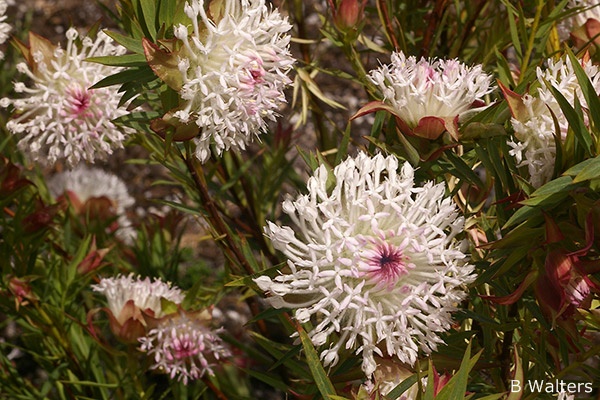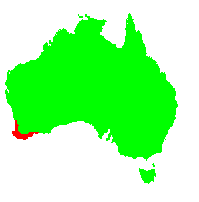General Description:
Pimelea is a genus of about 80 species, most of which are Australian but some also occur on islands to the north and in New Zealand. Most are shrubs but some annual species are found in tropical areas. The name “rice flower” has been applied to many members of the genus, a few of which are cultivated to a limited extent.
Pimelea spectabilis is an erect shrub which may reach about 2 metres in height but is usually smaller. The leaves are about 20-30 mm long, with a narrow elliptical shape, tapering gradually to a soft point. The flower clusters are typical of many Pimelea species in that they occur in globular shaped heads. However, the clusters are the largest in the genus and may be 50 mm or more in diameter and very conspicuous. The flower clusters are cream to white with a pink centre. Flowering occurs in winter and spring.
Because of its natural habitat in a dry summer climate, P.spectabilis has proven to be difficult to maintain in cultivation in areas with humid, wet summers. Some success has been achieved in southern Australia in well drained soils, preferably in a protected position for best quality flowers. There has been some work carried out in grafting of P.physodes onto hardier root stocks to extend the area for successful cultivation, but it is not known if any grafting experiments have been attempted with P.spectabilis.
Pimeleas, generally, are difficult to germinate from seed but some success has been achieved through treatment with smoke or smoked water. Cuttings are successful but care needs to be exercised in removing leaves from the lower parts of the cuttings as tearing of the thin bark of the stems is likely if leaves are stripped off. Grafting experiments would be worthwhile using root stocks of other Pimelea species that are hardy in the locality where the plant is to be grown.

Pimelea spectabilis
Photo: Brian Walters
 Australian Native Plants Society (Australia)
Australian Native Plants Society (Australia)